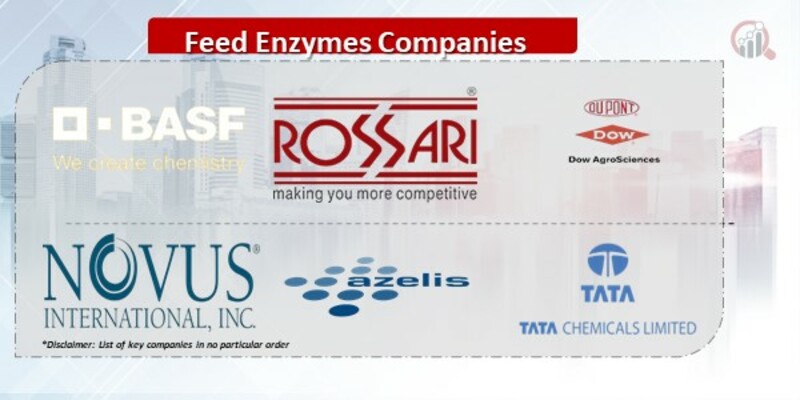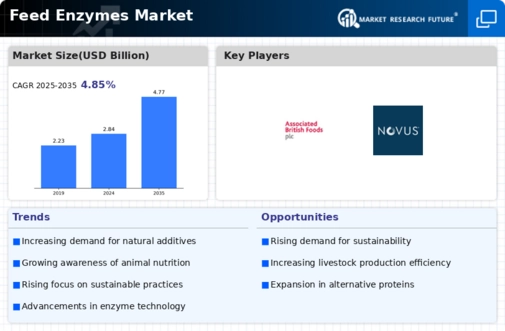Top Industry Leaders in the Feed Enzymes Market
Feed Enzymes Market Research Report

The Feed Enzymes Market is witnessing a dynamic and competitive landscape as the demand for enhanced animal nutrition continues to grow. with their expansive product portfolios and global presence. These companies are strategically positioned to capitalize on the increasing awareness among livestock producers about the benefits of feed enzymes in improving feed efficiency and animal performance.
Key Companies in the Feed Enzymes market include
- BASF SE (Germany)
- du Pont de Nemours and Company (U.S.)
- Associated British Foods plc (U.K)
- Koninklijke DSM N.V. (the Netherlands)
- Behn Meyer Holding AG (Germany)
- Adisseo France SAS (France)
- Azelis Holding S.A. (Belgium)
- Novus International Inc. (U.S.)
- Rossari Biotech Ltd. (India)
- Alltech Inc. (U.S.)
Strategies adopted by key players in the Feed Enzymes Market are diverse and centered around innovation, strategic partnerships, and mergers and acquisitions. Novozymes A/S, a prominent player in the market, has been a pioneer in developing enzymatic solutions for animal nutrition. The company emphasizes continuous research and development to introduce novel feed enzyme products that address the evolving needs of the livestock industry. DSM Nutritional Products has adopted a strategy of diversification, expanding its product offerings to cater to different animal species and market segments. BASF SE, through strategic acquisitions, has reinforced its position in the market, enhancing its capabilities to provide a comprehensive range of feed enzyme solutions.
Market share analysis in the Feed Enzymes Market considers several factors. The efficacy of feed enzyme products, their compatibility with various animal diets, and the ability to improve feed conversion rates are crucial factors influencing market share. Companies that invest in developing multi-enzyme formulations designed to target specific challenges in different animal species gain a competitive advantage. Moreover, pricing strategies, regulatory compliance, and effective distribution networks also play pivotal roles in determining market share in this highly competitive sector.
The Feed Enzymes Market is not only shaped by established players but also by the entry of new and emerging companies aiming to carve out a niche for themselves. These companies often focus on specific enzymes or target niche markets with unique needs. With a nimble and innovative approach, these emerging players bring fresh perspectives to the industry and challenge the status quo. As they gain traction, they may disrupt traditional market dynamics and compel established players to adapt their strategies.
Industry news in the Feed Enzymes Market reflects ongoing developments and advancements. The market has witnessed breakthroughs in enzyme technology, leading to the development of more stable and effective enzyme formulations. Innovations in enzyme delivery systems and improved understanding of enzyme-substrate interactions contribute to the continuous evolution of feed enzyme products. Additionally, increasing emphasis on sustainable and eco-friendly practices in animal farming has led to the development of enzymes that enhance nutrient utilization, reducing the environmental impact of livestock production.
Current company investment trends in the Feed Enzymes Market underscore a focus on research and development, sustainability, and digitalization. Companies are investing significantly in cutting-edge research facilities to enhance their enzyme discovery and development capabilities. Sustainability is a key driver, with a growing emphasis on eco-friendly enzyme production processes and packaging. Moreover, digital technologies are being leveraged for precision farming, enabling producers to optimize enzyme supplementation based on real-time data and animal health indicators.
The overall competitive scenario in the Feed Enzymes Market is characterized by a blend of established players consolidating their positions and emerging companies disrupting traditional dynamics. As the global demand for meat and animal products rises, the importance of efficient and sustainable animal nutrition becomes paramount. Companies in the feed enzymes sector must navigate evolving consumer preferences, regulatory landscapes, and technological advancements to stay competitive. Proactive investment in research and development, strategic collaborations, and a commitment to sustainability will be key for companies seeking to thrive in this dynamic and competitive market. The Feed Enzymes Market is poised for sustained growth, driven by the imperative to enhance animal nutrition and the ongoing quest for more sustainable and efficient livestock production practices.
Recent News :
October 26, 2023 - The global feed enzymes market, valued at over $1.3 billion in 2024, is chomping at the bit with new developments driven by sustainability, precision agriculture, and innovative enzyme blends. Here's a bite-sized look at the latest trends:
Green Grazing:
DSM, a leading enzyme manufacturer, unveils its "EcoFeed" initiative: This program focuses on developing sustainably sourced enzymes from renewable raw materials like corn stover and wheat bran, reducing the environmental footprint of feed production.
Start-up Novozymes partners with Brazilian biofuel company to produce animal feed enzymes from sugarcane waste: This collaboration showcases the potential of circular economy to create cost-effective and eco-friendly enzymes for the burgeoning Latin American market.
Targeting the Trough:
Chr. Hansen introduces its "Precision Enzyme Matrix" technology: This platform uses data analytics and machine learning to tailor enzyme blends to specific feed compositions and animal needs, maximizing nutrient utilization and animal performance.
AB Enzymes acquires a start-up specializing in gut microbiome analysis: This strategic move positions AB Enzymes at the forefront of developing enzyme blends that enhance animal gut health and improve feed digestibility.
Regulatory Nibbles:
The European Union tightens regulations on antibiotic growth promoters in livestock: This raises the demand for alternative feed additives like enzymes that can optimize nutrient uptake and improve animal health without antibiotics.
The US Food and Drug Administration approves a new enzyme for swine feed that enhances protein utilization: This approval opens doors for further innovation in enzyme design, catering to the specific needs of different animal species and feed types.
A Bite of the Future:
Research intensifies on "next generation" enzymes with multi-functional capabilities: These enzymes could not only improve digestion but also boost immunity, fight pathogens, and reduce greenhouse gas emissions from livestock.
Start-ups explore the potential of algal-based enzymes: These enzymes offer unique properties like thermostability and resistance to harsh gut conditions, potentially disrupting the market with their novel applications.









